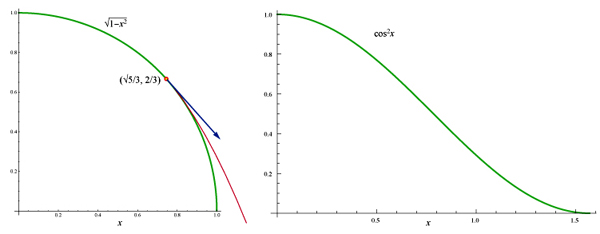I wonder if it is possible to characterize the class of gently falling functions, which I would like to define as follows. Let $g(x)$ be a $C^2$ function defined on an interval $R \subseteq \mathbb{R}$ of the real line. It will be no loss of generality for my purposes to assume that $g(x) \ge 0$ on $R$, and that $\max_{x \in R} \; g(x) = 1$. Imagine placing a particle on the curve at any point and letting it frictionlessly slide down the curve under the influence of gravity (with nominal gravitation constant 1). Say that $g(x)$ is gently falling if, for every start point, the particle never "ski-jumps off" the curve in its downward descent.
Example 1.
$g(x) = \sqrt{1-x^2}$ for $R=[0,1]$ is not gently falling.
If I've calculated correctly, a particle starting near
the max $(0,1)$ will separate from the curve after falling
height $1/3$.

Example 2. $g(x) = \cos^2(x)$ for $R=[0,\pi/2]$. Under the assumptions above, I believe this is gently falling: a particle released at any point remains on the curve throughout its descent.
Example 3. (Added later.)
$g(x)$ is a scaled and translated piece of $\cos^2(x)$ for $x>2$, preceded by a linear ramp
tangent to $\cos^2(x)$:

Now a particle released at the max gathers enough momentum to lift off at the $x=2$ transition.
So $g(x)$ is not gently falling.
I've worked out a condition that (I think!) needs to be satisfied for $g(x)$ to be gently falling, under my assumptions. Let $g=g(x)$, $\dot{g} = dg/dx$, and $\ddot{g} = d^2g /dx^2$. Then, for $g$ to be gently falling, $$2 (1-g) \ddot{g} + (1 + \dot{g}^2) \ge 0$$ should be satisfied for all $x$. For the quarter circle, the left side of this inequality becomes $$ \frac{x^2}{1-x^2} - 2 \left(\frac{x^2}{\left(1-x^2\right)^{3/2}}+\frac{1}{\sqrt{1-x^2}} \right) \left(1-\sqrt{1-x^2}\right)+1 $$ which simplifies to $$ \frac{3}{1-x^2} -\frac{2}{\left(1-x^2\right)^{3/2}} $$ which is positive for $x$ less than the root $\sqrt{5}/3 \approx 0.745$, in accord with the picture above. When I work out the calculation for the second example, there are no roots within $R$.
I have two questions. First, has anyone seen a curve definition like this before? If so, even for tangentially related ideas, I'd appreciate a pointer. Second, if my gently-falling inequality on $g$, or some analogous inequality, is correct, are there general methods to characterize all the functions $g$ that satisfy it? Right now I can determine if any given function is gently falling, but I don't have a sense for the contours of the set of all gently falling functions. Thanks for any ideas!
(The motivation for these questions is a bit far from their form above, and it might distract from the mathematics to explain.)
